15 Inch Rubber Tarp Straps w/ Crimped S Hooks | 20 PACK
15 Inch Rubber Tarp Straps w/ Crimped S Hooks | 20 PACK
Couldn't load pickup availability
15 Inch Rubber Tarp Straps w/ Crimped S Hooks
Tarp Straps are used to Affix the Tarp to the Trailer; Tarp Straps are NOT legal as Load Securement and Drivers Can be Ticketed for Any Use of a Tarp Strap as a Primary Tie Down
- QTY 20 PACK
- 100% Natural Rubber
- S-Hooks Crimped on 21" & 31" to Prevent Tarp Damage
- Excellent 'Memory' - Strap Rebounds to Original Length
- Elongation Tested to 5x the Original Length
- Optimized for Cold Weather Use
- 25+ Year, Market Proven Product by Jafferjee Bros. of Sri Lanka
- Meets ASTM D1418 - 10a
FULL BOX QTY: 50
| SKU: 15RSX20 | ITEM: 15 Inch Rubber Tarp Straps w/ Crimped S Hooks 20 Pack | WT: 4.8 lbs |
More Info
** ANSI/ISEA Z87.1-2015 Eye Protection Required **
Tarps can be heavy and awkward; choose the right tarp for the job to control the size, weight, and strength needed to handle it. Use mechanical aids to apply and remove tarps. When moving the tarp by hand, use good body mechanics. Face the tarp, keep your back straight and pull the tarp out with your hands at about waist height. Avoid twisting or pulling down with your arms overhead. Keep a firm grip on the tarp to prevent slipping. Spread your feet, shoulder-width apart, and stagger them slightly for the most power and stability. Watch for surface winds or gusts from the traffic that could cause the tarp to fly away.
To remove a tarp, loosen it by fanning to move air underneath. Use your arms, legs, and body weight to pull the tarp off the truck; watch for unstable loads! Lay the tarp out on a clean, flat area and check for holes or damage. Don’t walk on tarps to avoid slips and tarp damage. Get help to fold it.
Plan a pickup or delivery job before you drive to a site. Know the site layout for the customers you visit most. Get advanced information on the load or material details and loading/unloading procedures, including available equipment and help. Consider the truck type, height, and access points before you go. Ask directly about the tarping policy; can it be done on-site, or will you need to find a safe area outside the facility? Never tarp on the side of a busy road or highway.
Rubber is a term that refers to compounds of elastic made into polymers that are heat cured or vulcanized into shapes we can use. Tarp straps, gaskets, and shoe soles are several of the familiar end products. Rubber is often compounded with materials to make it harder or softer, more stretchy or less stretchy, and more abrasion resistant or less abrasion-resistant.
Ethylene Propylene Diene Monomer - or - EPDM is a chemically-derived base polymer with excellent resistance to most materials except oil. EPDM performs best in high ozone and high sunlight environments or around chemicals, steam, or environmental temperature extremes.
Natural Rubber is a tree-based polymer grown in parts of the world, ideally with high rainfall and humidity, high sunlight, and little wind. In plantations, Rubber trees can have a useful production life of up to 25 years. Natural Rubber works best in cold, wet environments or where high rebound, adhesion to metal, or resistance to abrasion is required.
Contact Us
Contact Us

TOLL FREE: 1-84-GOSTRAPS / 1-844-678-7277
SALES: sales@RatchetStrap.com
ACCOUNTING: accounting@RatchetStrap.com
GENERAL: info@RatchetStrap.com
We are available seven days a week and at most hours. We appreciate the time to work with you and answer any question that you might have.
Share
















